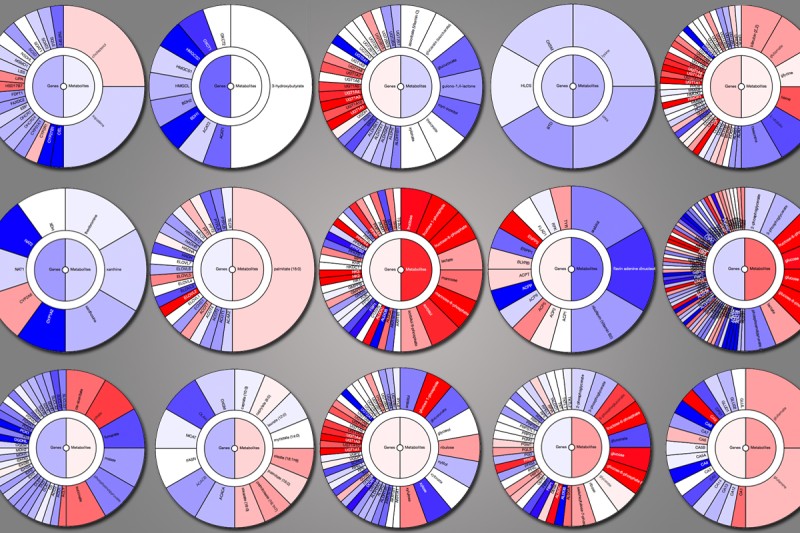
The “metabologram” allows researchers to easily search and view metabolic data obtained from kidney cancer tumors.
Much of what we know about cancer comes from studying genes. By sequencing genes in tumors, for example, scientists have learned what mutations are typically found in different cancer types. Genetic methods can also be used to survey which proteins are made in tumors.
Yet this information provides only an indirect measure of how cancer cells operate. To really capture that, you need to know about the dynamic chemical changes occurring in these cells; you need to know about cancer metabolism.
Tracing the products of cell metabolism, known as metabolites, is not easy to do. “Looking at metabolites in cancer has been very difficult because the technology was not available,” says James Hsieh, a physician-scientist at Memorial Sloan Kettering and an expert in kidney cancer. “Until recently, we didn’t have the capacity to look at hundreds, even thousands, of different metabolites inside of cells.”
But with advanced biochemical methods, these myriad metabolites are finally coming into focus. As they report in a new study published in the journal Cancer Cell, Dr. Hsieh’s team has used such methods to profile metabolic changes in hundreds of kidney cancer tumor samples. What’s more, they’ve developed a new online tool that will help researchers make sense of this vast data pool, highlighting previously unknown connections between metabolism and clear cell renal cell carcinoma — the most common, lethal form of the disease.
Metabolism Explained
Think of a cell as a factory. If genes provide the floor plan for the factory, and proteins make up the built environment, then metabolism is the movement of materials through the factory to make products.
For many years, investigators wanting to understand cancer metabolism looked at enzyme levels — proteins that catalyze chemical reactions. Publically accessible databases, such as those maintained by The Cancer Genome Atlas (TCGA), provide this information. The problem is that enzyme levels don’t necessarily tell you whether, and at what rate, metabolites are actually being made.
“There’s no good way to infer how changes in metabolite levels are connected to enzyme levels,” says Ed Reznik, a postdoctoral fellow in computational biology at the Sloan Kettering Institute who is a co-first author on the study. “You really have to go after the metabolites directly.” (To continue the factory analogy, just because a forklift is present on the shop floor doesn’t mean it’s being used.)
To track metabolites, the team obtained samples of tumor tissue and normal tissue from 138 clear cell kidney cancer patients treated at MSK. A surgeon on the team and the paper’s other co-first author, Ari Hakimi, performed these operations.
The researchers then used mass spectrometry and liquid and gas chromatography to analyze the levels of more than 800 different metabolites in these samples. By comparing the levels of metabolites in tumors with those in normal tissues, they were able to chart the rise and fall of these chemicals.
There’s an App for That
Making sense of the metabolic data was challenging at first, since there was so much of it. “If you look at human metabolism, there are upward of 5,000 distinct biochemical reactions,” says Dr. Reznik. “It’s really hard to make sense of that in a way that humans can parse.”
So the team decided to build a tool that would help them visualize what was going on. Working with a team of programmers, Dr. Reznik developed what he calls a “metabologram,” which allows users to review the metabolite data for any number of different metabolic pathways, one pathway at a time. Users can compare metabolites between tumor samples and normal samples, or between lower-stage tumors and higher-stage tumors. They can also see how the metabolic data line up against the gene expression data obtained from TCGA.
With the help of their new tool, the team made some startling discoveries. They found that the genetic data from TCGA were not always reflective of what was happening to metabolites in kidney cancer cells, and that the metabolic data help to make better sense of the clinical behavior of kidney cancer tumors.
“Our data are actually much more consistent with the human data obtained from pathology,” Dr. Hsieh says.
Charting Aggressiveness
Taking a bird’s-eye view of the metabolic data, the team found four distinct groupings, or clusters, of tumor samples that they could distinguish based on levels of metabolites. The clusters differed in their level of tumor aggressiveness and highlighted who the high-risk patients were.
“You can use the metabologram to get a sense of what’s driving the aggressive tumors from a metabolic standpoint,” Dr. Hakimi says. Once you have that, you can then think about ways to target that altered metabolism.
The team hopes that the new tool, which is being made freely available online, will help researchers generate novel hypotheses about metabolism and kidney cancer, and even encourage other teams to create metabolograms for other cancer types.
“The goal is ultimately to use this information to improve clinical prediction for kidney cancer and to understand how best to treat it,” Dr. Hsieh says.




